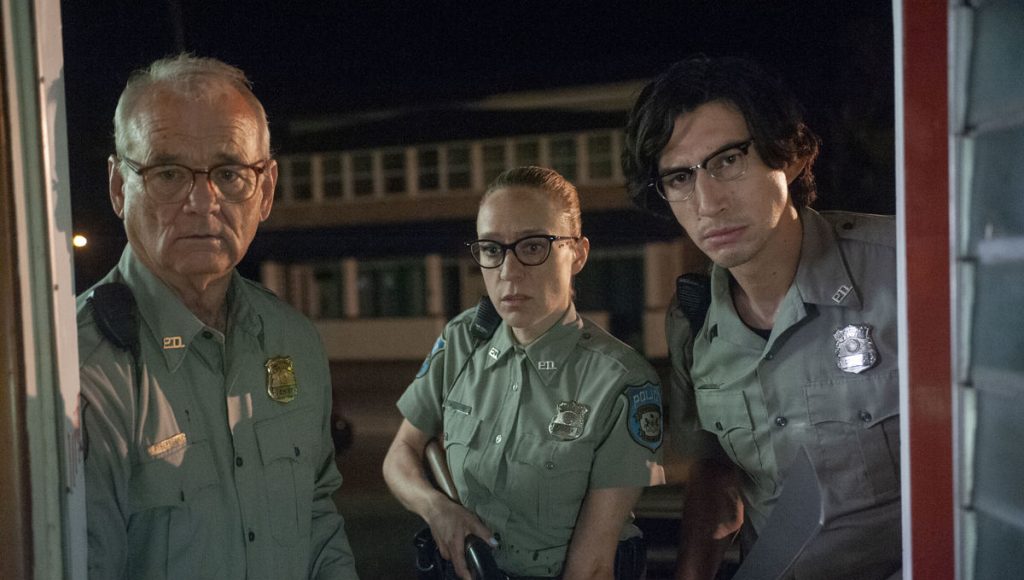The Dead Don’t Die | Film Review


In 2019, people see themselves more often and in more ways than at any other moment in history. What’s more, we crave that sight. Climbers are dying on Mount Everest in record numbers because there’s a selfie waiting for them at 30,000 feet. We’re at a peak awareness of self, yet it hasn’t made us any wiser. We’ve got despots, cultural ADHD, and permanently crooked necks.
Jim Jarmusch seems to think we might do better if we could step back and look at ourselves as movie characters. At least if someone in a movie tried to scale a deadly mountain for Instagram’s sake, we could all shout: “Don’t go up there!” This low-hanging dramatic irony is the comedy, the observation, the drudgery and the big old shrug at the end of The Dead Don’t Die. Facing a zombie invasion, the citizens of the fictional town of Centerville behave with exactly the same helpless, pyrrhic momentum most of us do each day. In the movie, daylight hours are growing suspiciously longer, and the town’s response is to drink more coffee. Spooked by the undead’s impending arrival, all the animals have made a run for it, yet the humans call after them like furniture that’s absconded. It’s beyond stupidity; it’s pure magnetized fatalism.
The only things the citizens of Centerville seem to know for certain are from movies. As Officer Ronald Peterson, Adam Driver is quite sure (and quite right) that you kill a zombie only through decapitation. Here, Jarmusch is either still making fun of us, or looping in himself. Now 13 feature films in, the 66-year-old has sustained a legendary independent film career staging his human ponderments inside Westerns, gangster flicks and vampire romances. If he, or we, could solve the world’s problems through a comprehensive understanding of genre film conventions, we’d have 50 years of universal healthcare to our names and the oceans would be receding.
Before you pin this purely political reading on me, though, The Dead Don’t Die plays out like it’s trying to win a movie prize for “thinnest veil of the Trump Era.” Only a freshman English major would feel comfortable even calling this zombie-cum-global-warming movie an allegory. The literal horror elements of the film bleed uncontrollably into the subtext and seem present only because it would be uncouth to flash a title card that reads “AHEM, climate change caused this.” Instead, Jarmusch invents a perfunctory backstory about polar fracking knocking the planet off its axis.
It’s a facile choice, and the zombies are neither interesting nor sickening. (Some are famous though!) Jarmusch is more concerned with the civilian response anyway. The Dead Don’t Die is his homespun version of Mars Attacks! — a messy, unsatisfying disaster movie a dozen characters deep (in this case, Bill Murray, Tilda Swinton, Adam Driver, Chloë Sevigny, Danny Glover, Caleb Landry Jones, Selena Gomez, the RZA, etc.), which doesn’t compel through action so much as draw out the uncomfortable or delighted chuckles of subconscious recognition. It’s still very much a Jarmusch movie, though. There’s a great deal of tonal tranquility even as the town population is picked off one by one. And to be charitable to the film’s theme, the auteur is fittingly distracted from the chaos at hand. He cares more about characters repeatedly plugging Sturgill Simpson’s theme song for the movie than what makes for suspenseful horror.
In that vein, the best moments of The Dead Don’t Die have precious little to do with zombies. At one point, Driver and Murray are examining a cemetery for any upturned graves when they notice a communal children’s plot, compact and fenced off from the rest of the lawn. Why did they separate the graves, Driver asks his commanding officer. Murray doesn’t know: some kind of 19th-century tradition.
“Just seems like a bad idea somehow,” Driver muses, with a bit of the deadpan foresight that defines his character. Even if the movie overplays its hand in this respect, Driver comes out best among the characters for the repeated observation, “I don’t think this is going to end well.” The townsfolk can’t believe his pessimism, even though the apocalypse is rapping on their windows. Our behavior and expectations, Jarmusch reminds us, are stranger than any string-bean filmmaker with sunglasses and shock-white hair, not to mention that filmmaker’s friends playing katana-wielding Scotswomen (Swinton) and stumbling undead (Iggy Pop).
Some of these observations work, some bits work, idiosyncrasies are acceptable, but The Dead Don’t Die (much like, oh I don’t know, Mars Attacks!) doesn’t work in the macro. It has fatalism on its mind, but it is either too polite or too fidgety to feel powerful, or even engaged. Myriad main characters are disemboweled by zombies in this movie, and I can’t confess to feeling much, nor did I sense much terror or disgust in the film itself. Is the point that the time for heroism has passed? What about innocence? That’s a conundrum facing any climate change movie: what to do artistically with the fact that, facing our own destruction, we seem not to care or, even more bleak, are not able to care.
Twenty years hence, when the world is melting but we’re still tweeting about our favorite deep-reads of George Romero films, maybe someone will pen a convincing piece about how The Dead Don’t Die was one of our age’s most thematically accurate warnings of impending doom, and that anyone who occupied their minds with whether it was a good movie was part of the problem. Posterity, forgive me: this movie is just a goof.
-Chance Solem-Pfeifer



